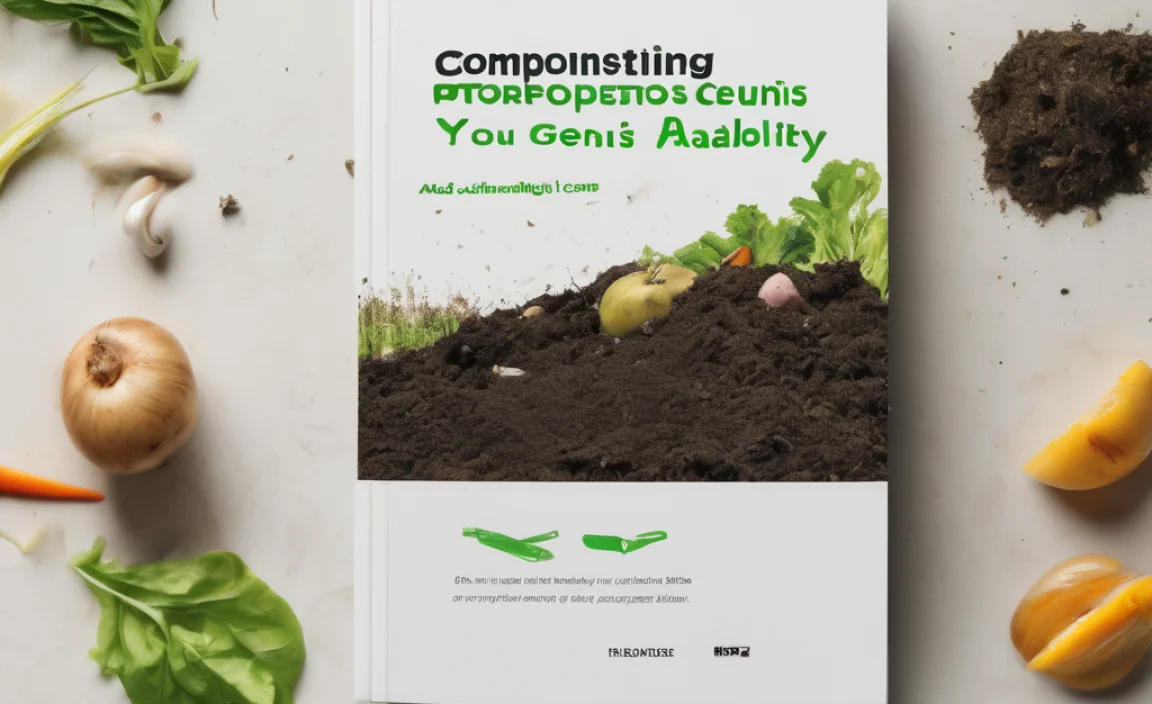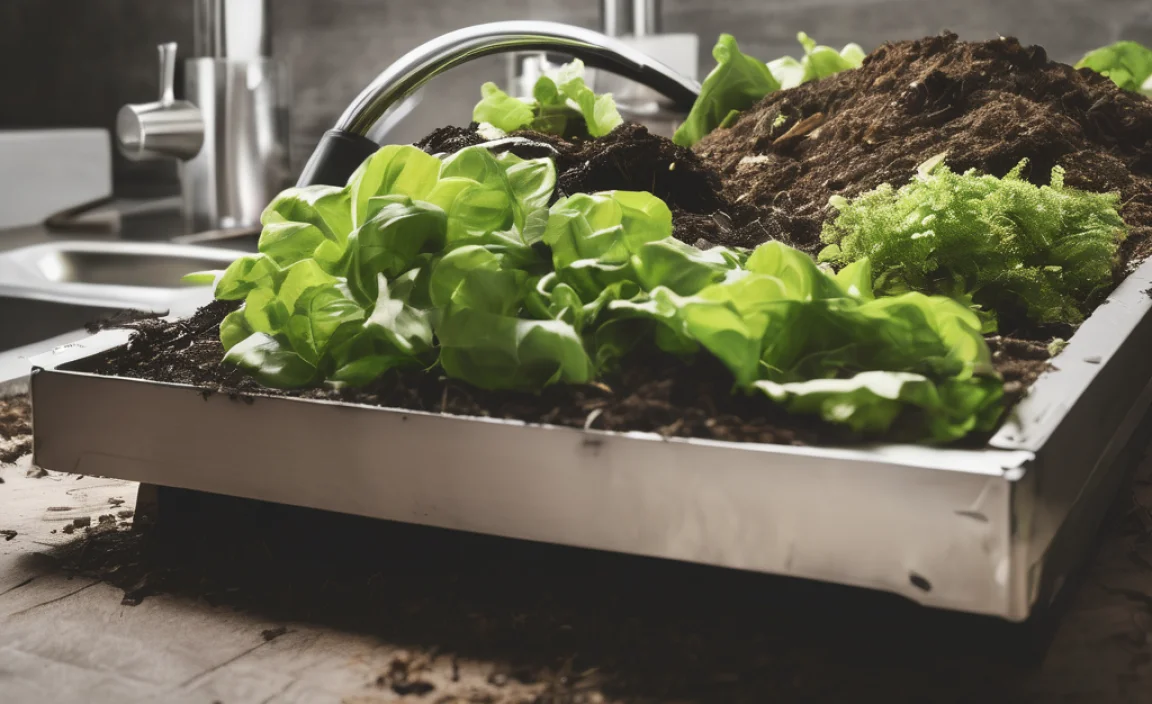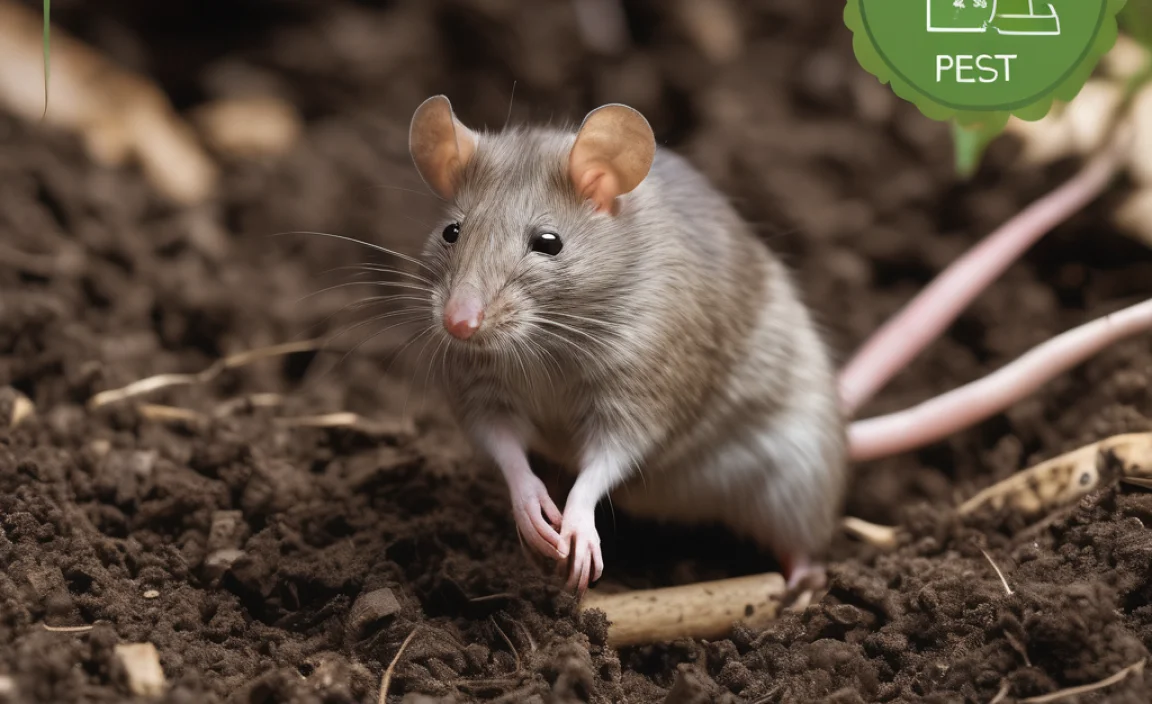Getting your compost pile just right can feel like a puzzle, and one of the trickiest pieces is temperature. Too cold? It takes forever. Too hot? You might kill off the good stuff. It’s a common frustration for home composters, but don’t worry! My aim is to make understanding “in-vessel composting temperature” simple and clear. We’ll break down what you need to know, why it matters, and how to keep your compost cooking perfectly. Ready to turn your kitchen scraps into garden gold without the guesswork? Let’s dive in!
Your TopChooser Guide to In-Vessel Composting Temperature
Hey there, neighbor! Troy D Harn here, your go-to guy for making DIY and home projects less complicated. Today, we’re talking about something super important for happy composting: temperature. Whether you’re using a fancy tumbler, a sturdy bin, or even just a pile in the corner, getting the temperature right is key to making good compost fast. Let’s demystify this whole “in-vessel composting temperature” business so you can have rich, dark compost ready for your garden with confidence.
Composting is one of the best ways to reduce waste and create amazing fertilizer for your plants. But when your compost pile just sits there, or smells a bit funky, temperature is often the culprit. Don’t let that discourage you! We’ll walk through this together, step by step.
Why Does In-Vessel Composting Temperature Matter So Much?
Think of your compost pile as a bustling city for tiny microbes. These little workers—bacteria and fungi—are the ones doing the heavy lifting, breaking down your food scraps and yard waste. Temperature is like the thermostat for their city. If it’s too cool, they slow down their work, and your compost takes months or even years to mature.
On the flip side, if the temperature gets too high, you can actually harm these beneficial microbes. You might end up with a pile that’s more like a hot desert than a micro-friendly metropolis. The goal is to find that sweet spot where these microorganisms thrive and work efficiently, turning your waste into nutrient-rich compost.
Getting the temperature right also helps in a few other crucial ways:
- Faster Decomposition: Warmer temperatures speed up the breakdown process, meaning you get finished compost much quicker.
- Killing Pathogens and Weed Seeds: Higher temperatures (the thermophilic phase) can help kill off harmful bacteria and unwanted weed seeds. This is great for your garden next season!
- Reducing Odors: A healthy, actively “cooking” compost pile generally smells earthy and pleasant, not rotten or sour.
The Three Stages of Compost Temperature
Composting isn’t just one big temperature event. It actually goes through different phases, and understanding them helps you manage your pile.
1. Mesophilic Stage (The “Getting Started” Phase)
This is where it all begins. When you first add your materials and provide some moisture, the mesophilic microbes get to work. They love moderate temperatures.
- Temperature Range: 50°F to 109°F (10°C to 43°C)
- What’s Happening: Microbes are actively consuming the readily available organic matter. This stage is more about the initial breakdown and getting the process going.
- What You’ll See: Your pile might start to feel slightly warm to the touch, especially in the center.
2. Thermophilic Stage (The “Hot Cooking” Phase)
If you’ve got the right mix of greens (nitrogen-rich) and browns (carbon-rich), and plenty of air and moisture, your pile will heat up significantly. This is the “hot composting” phase, where the heavy hitters come out to play.
- Temperature Range: 131°F to 160°F (55°C to 71°C)
- What’s Happening: Different types of bacteria that thrive in high heat take over. They break down tougher materials much faster. This stage is crucial for killing pathogens and weed seeds. For effective pathogen reduction, temperatures should ideally reach and maintain at least 131°F (55°C) for a sustained period.
- What You’ll See: Your compost thermometer will show these high temperatures. You might also see steam rising from the pile.
- Importance: Reaching this range is a sign of a healthy, active compost pile. It dramatically reduces the time it takes to break down materials.
For a great overview of composting science, the University of California, Davis has some excellent resources on the scientific principles behind composting.
3. Cooling and Curing Stage (The “Maturing” Phase)
Once the readily available food sources are gone, the thermophilic microbes start to die off, and the temperature begins to drop. Mesophilic microbes, along with fungi and larger organisms like worms and insects, then take over to mature the compost.
- Temperature Range: Starts to fall back to ambient (surrounding) temperature.
- What’s Happening: Slower decomposition occurs, and the compost begins to stabilize. Humus, the rich, stable organic matter that gives compost its value, starts to form.
- What You’ll See: The pile cools down. It should start to smell earthy and look like dark, crumbly soil.
What’s the Ideal In-Vessel Composting Temperature?
So, what’s the magic number? For fast, effective composting, the ideal target temperature is in the thermophilic range: 131°F to 160°F (55°C to 71°C).
Why this range? It’s hot enough to efficiently break down organic matter and, importantly, kill off weed seeds and most harmful pathogens. This means you’re not just making compost; you’re making clean, valuable compost.
However, it’s important to note that not all home composting systems are designed to reach these high temperatures, nor is it always necessary, especially if you’re not concerned about killing weed seeds or if you’re using worms (vermicomposting). But for a typical in-vessel system aimed at quick results, this is your golden zone.
How to Measure Your In-Vessel Compost Temperature
You can’t manage what you don’t measure! To know if your compost pile is heating up properly, you’ll need a compost thermometer. These aren’t fancy or expensive, and they’re essential for any serious composter.
Choosing the Right Compost Thermometer
- Length: Look for a thermometer with a long stem, at least 10-12 inches, so you can get it deep into the center of your pile or bin.
- Readability: A dial with a clear, easy-to-read gauge is best. Some have color-coded zones to indicate the different stages.
- Durability: Stainless steel is a good material for the stem as it’s durable and easy to clean.
You can find compost thermometers at most garden centers, hardware stores, or online retailers. They’re a small investment for a lot of composting insight.
Using Your Compost Thermometer
- Insert Carefully: Gently push the stem of the thermometer into the center of your compost pile or bin. Ensure the sensing area (usually the bottom few inches of the stem) is buried.
- Wait for Reading: Leave it in for a few minutes until the needle stops moving. This gives you an accurate temperature reading.
- Check Regularly: For active composting, check the temperature daily or every other day, especially during the initial heating phase. As the pile matures, you can check less frequently.
- Record (Optional but Helpful): Jotting down temperatures can help you see patterns and understand what adjustments your pile might need.
Factors Affecting In-Vessel Composting Temperature
Several things influence how hot your compost pile gets. Understanding these will help you troubleshoot and optimize your composting success.
1. The Carbon-to-Nitrogen Ratio (C:N Ratio)
This is the most critical factor. Microbes need both carbon (for energy) and nitrogen (for protein and reproduction). Too much of one and not enough of the other will slow things down. Generally, a brown-to-green ratio of about 2:1 to 3:1 by volume is a good starting point for heating.
- Greens (Nitrogen-Rich): Fruit and vegetable scraps, grass clippings, coffee grounds, tea bags, fresh plant trimmings.
- Browns (Carbon-Rich): Dried leaves, straw, shredded paper (non-glossy), cardboard, sawdust, twigs.
For a deeper dive into what materials to compost, check out the Environmental Protection Agency’s excellent composting guide.
2. Moisture Content
Microbes need water to live and work. Your compost pile should be as damp as a wrung-out sponge – moist, but not soggy. Too dry, and the microbes can’t function, and the pile won’t heat up. Too wet, and you’ll suffocate the beneficial aerobic microbes (the ones that need air) and can lead to smelly, anaerobic conditions.
3. Aeration (Oxygen)
Just like us, the microbes in your compost pile need oxygen to breathe. This is why in-vessel composting (like tumblers that can be turned) is so effective, as it helps introduce air. A lack of oxygen will cause the pile to become dense, wet, and smelly, and it won’t heat up properly. Regularly turning or aerating the pile is crucial.
4. Volume of Material
A compost pile needs a certain minimum mass to generate and retain heat. If your bin is too small or you haven’t added enough material, it might struggle to heat up. For effective hot composting, a pile generally needs to be at least 3 feet x 3 feet x 3 feet (1 cubic yard or about 1 cubic meter). Smaller bins will still compost, but they might be more challenging to get to those high thermophilic temperatures and may take longer.
5. Particle Size
Smaller particle sizes mean more surface area for microbes to work on. Chopping up your kitchen scraps and shredding your yard waste will help the composting process and heat generation. Think of it like making food smaller for easier digestion!
Troubleshooting Common In-Vessel Composting Temperature Issues
Don’t despair if your compost isn’t heating up. It’s a common learning curve!
Problem: My Compost Pile Isn’t Heating Up
- Check the C:N Ratio: You likely have too many browns (carbon) or not enough greens (nitrogen). Add more nitrogen-rich materials like kitchen scraps, grass clippings, or coffee grounds.
- Check Moisture: Is the pile too dry? Add water and mix thoroughly. Aim for that wrung-out sponge feel.
- Too Small: If your bin is small, or you don’t have enough material, it might struggle to retain heat. You may need to add more materials or insulate the bin during cooler months.
- Needs Turning: Your pile might be too compacted, preventing airflow. Turn it to introduce oxygen.
Here’s a quick table to help you diagnose:
| Symptom | Possible Cause | Solution |
|---|---|---|
| Pile not heating up | Too many browns (carbon) | Add greens (nitrogen). |
| Pile not heating up | Too dry | Add water and mix. |
| Pile not heating up | Lack of aeration/compaction | Turn the pile. |
| Pile too wet and smelly | Too many greens (nitrogen) or too much water | Add browns (carbon) and turn to aerate. |
| Pile is hot but not breaking down | Too dry or lack of nitrogen | Add water and mix; add greens. |
Problem: My Compost Pile is Too Hot (Over 160°F / 71°C)
While high heat is good, excessively high temperatures can sometimes harm beneficial microbes or even cook your compost materials too quickly. This usually means you have too much nitrogen or not enough air.
- Too Much Nitrogen: Add a good amount of brown, carbon-rich materials like dried leaves, shredded cardboard, or sawdust.
- Lack of Air: Turn the pile thoroughly. This introduces oxygen and helps release some of the excess heat.
- Too Wet: If it’s also very wet, turning will help it dry out a bit and get air flowing.
Remember, these high temperatures are usually temporary. Once the readily available nitrogen is used up, the pile will naturally cool down.
Problem: My Compost is Smelly
A healthy compost pile should smell earthy. Foul odors (like ammonia or rotten eggs) usually indicate an imbalance, most often too much moisture and not enough air (anaerobic conditions).
- Too Wet: Add dry, carbon-rich “brown” materials like shredded newspaper, cardboard, or dry leaves.
- Lack of Air: Turn your compost pile frequently. If you have a tumbler, ensure you’re turning it regularly. If it’s a bin, use a pitchfork or compost aerator to mix it up well.
- Too Much Green Material: If you’ve added a lot of grass clippings or kitchen scraps without enough browns, it can become dense and anaerobic. Balance it out with browns and aerate.
Tips for Maintaining Optimal In-Vessel Composting Temperature
Consistency is key! Here are some practical tips to keep your compost happily cooking:
- Start with a Good Mix: Always aim for a good balance of greens and browns when you add material. A good rule of thumb is to layer or mix them together as you add them.
- Chop it Up: Smaller pieces break down faster and help the pile heat up more efficiently.
- Maintain Moisture: Check the moisture level regularly. Add water if it’s dry, or add browns and turn if it’s too wet.
- Turn Regularly: This is non-negotiable for most in-vessel systems. Turning introduces that vital oxygen and redistributes moisture and heat. Aim to turn every few days to a week, especially when trying to achieve high temperatures.
- Location Matters: Place your composter in a spot that gets some sun, especially in cooler weather. This can help warm it up. However, avoid direct, scorching sun in very hot climates, as it can dry it out too quickly.
- Insulate in Winter: If you compost through colder months, consider insulating your bin with straw bales or an insulating blanket to help retain heat.
In-Vessel Composting vs. Other Methods & Temperature
When we talk about “in-vessel composting,” we’re usually referring to enclosed systems like compost tumblers, bins, or static cylindrical composters. These are fantastic for keeping things tidy and can be very efficient.
- Compost Tumblers: These are great for aeration and can heat up quickly due to being enclosed and easily turned. They are ideal for small to medium-sized households.
- Stationary Bins: These can also reach good temperatures, especially if they are well-insulated or if you are diligent about turning them. They often hold more material than tumblers.
- Open Piles: While often requiring more space and might be less tidy, well-managed open piles can also get very hot. However, they can lose heat and moisture more easily than contained systems.
- Vermicomposting (Worm Composting): This is a bit different! Worm bins operate at much cooler temperatures, typically between 55°F and 77°F (13°C to 25°C). The worms themselves process the material, not high heat from microbes. Trying to get a worm bin hot is actually harmful to the worms.
For most people looking for a straightforward, contained solution, understanding “in-vessel composting temperature” is your key to success. It allows you to manage the conditions more precisely than an open pile.
FAQ: Your In-Vessel Composting Temperature Questions Answered
Let’s tackle some common questions beginners have about compost temperature.
Q1: How hot does compost need to be to kill weed seeds?
A1: To reliably kill most weed seeds, your

I am passionate about home engineering. I specialize in designing, installing, and maintaining heating, ventilation, and air conditioning systems. My goal is to help people stay comfortable in their homes all year long.



